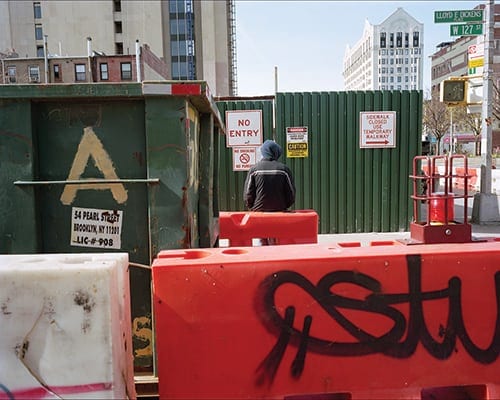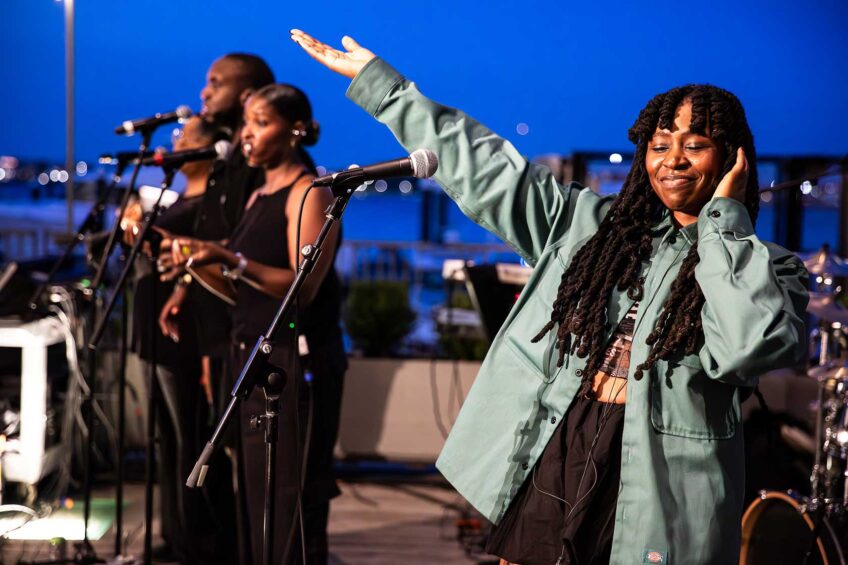When Construction Comes: Cooper Gallery exhibit highlights Harlem gentrification
Cooper exhibit highlights Harlem gentrification

Through July 15, Harvard’s Ethelbert Cooper Gallery of African and African American Art analyzes the history and changes in a historic neighborhood in “Harlem: Found Ways.” Anchored by two photo series by Dawoud Bey, created 40 years apart, the exhibit highlights the gentrification that’s changing Harlem’s identity as a famed black culture capital.

Author: Melissa BlackallArtist Abigail Deville installing her piece “Sarcophagus Blue” (2017) for the Ethelbert Cooper Gallery of African and African American Art’s new exhibition “Harlem: Found Ways.”

Author: Melissa Blackall(l-r) photographer Dawoud Bey, Harvard Professor and Hutchins Center Director Henry Louis Gates Jr., Ethelbert Cooper Gallery of African and African American Art Director Vera Ingrid Grant and London art gallery owner Amar Singh attend the Opening Night celebration of the Cooper Gallery’s new exhibition “Harlem: Found Ways” in Cambridge.
On the Web
For more information about “Harlem: Found Ways,” visit: www.coopergallery….
Bey’s first photo series, “Harlem, USA” (1974-1979) shows a very different neighborhood than “Harlem Redux” (2015-2016). The original series features black and white photographs of Harlem’s artistic and socially rich community. “A Boy in Front of the Loew’s 125th Street Movie Theater” (1976) shows a young boy with dark, wide sunglasses leaning against a railing in front of the theater’s ticket window. He’s relaxed, confident and comfortable. He confronts the viewer directly, not aggressively, but as someone in his own territory.
Thirty-nine years later and two streets up, Bey shot “Young Man, West 127th Street.” The “Harlem Redux” series is all in color, an artistic choice that expresses the substantial changes since the nostalgic, black-and-white days of the earlier series. The man mentioned in the title is far back in the middle of the frame, hard to spot amidst myriad construction materials. Bright orange barriers, forest green dumpsters and blunt warning signs clutter the frame. The construction alone is an indication of the ongoing gentrification, but the distanced figure, anonymous with his back to us and his hood up, also suggests an emotional distance and loss of identity.
“Gentrification is currently destabilizing a number of once majority black communities in this country, causing significant demographic shifts and population displacement while also erasing traces of those communities’ significant African American social and cultural history,” says Bey. He’s drawn to photography as an artistic medium because of its truth-telling reputation. Certainly photographs can be manipulated, and often are, but there’s an initial trust in what the eye sees.
Though Bey’s work is central to the exhibit, work by artists Abigail DeVille, Glenn Ligon, Howard Tangye, Nari Ward and Kehinde Wiley fill out the installation. DeVille created a small boat filled with disembodied limbs, rising gracefully and upside down from the boat’s bottom. The piece, named “Sarcophagus Blue,” nods both to a history of physical oppression through capture and control, and to a future of shared risks: “We’re all in the same boat.”
The exhibit is especially applicable in a Boston struggling with its own gentrification problems. With luxury condos rising on every block and little affordable housing to offset it, Bey’s lone figure lost amidst construction debris feels harshly relatable.







